|
|
|
|
|
|
|
|
|
|
|
||
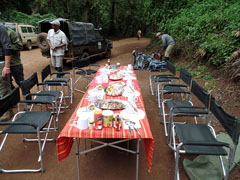 Lunch at Lemosho trailhead. |
 Moses and hand-washing protocol. |
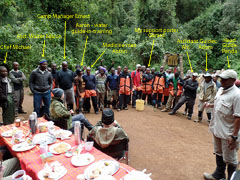 Annotated porters meeting. |
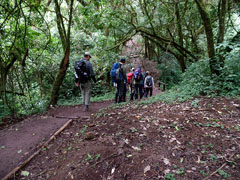 On the forest trail. |
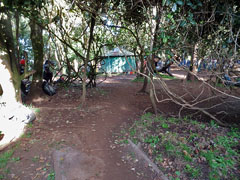 The Forest Camp (9200 ft.). |
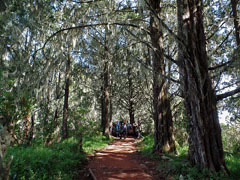 On the forest trail. |
|
Day 2 - Monday, July 13, Forest
Camp to Shira I Camp Although I didn't get much sleep the previous night, I felt a bit better this day and was hopeful that I dodged a bullet here. My throat was much better and while I had a runny nose, my appetite was better. Our morning routine is that Moses wakes us up (at about 6:30 a.m.) with a hot cup of coffee or tea. I brought along hot apple cider as my "snack" and had that every morning - I think Moses liked that because it was easy for him to make! I also tended to get up earlier than "required" in part so that I could take my thyroid meds with enough time before breakfast. And, I seem to be the slowest packer and needed the additional time. Every day we have to repack our duffel, which in my case is carried by Gerard. Penda has assigned a porter to each of us for this task, so that it is always the same person every day and someone he trusts. [Thompson pulls porters from their database of 700 porters, but Penda gets to personally pick some as do Adam and Ahi.] Finally, we have to pack up our day pack and bring it with us to the dining tent for breakfast. Our morning meal consists of some kind of hot cereal, eggs (fried or scrambled), generally some sausage (which looked awful but were delicious), toast and fresh fruit. Hot water of course for tea, coffee or cocoa. When we're done we only have about 15 minutes to take care of business before we are off to the races. We only have about an hour of hiking in the forest before we enter into the next zone - the heath. This terrain is made up of tall grasses and large bushes. Everything on this hike reminded me of a slightly off-skew version of Grand Canyon hiking (well, except the forest). These bushes sort of looked like juniper. Later I would see stuff that kind of reminded me of Mormon tea. The only thing missing - thank goodness - was cactus! Just looking at the surroundings you wouldn't imagine that there is much water here, but the melt from the glaciers and snow up the mountain keep a lot of little streams in business, which is where we would get our water from every day. Now that we were out of the forest it was nice to finally be able to see more of the countryside, but Kilimanjaro (or, Kili, as it is often called) is out of sight from us on this long western approach. For this hike I brought along my SPOT GPS tracker. I wasn't sure how good a job it was doing at pinging the satellite from the forest, but in the open spaces that wasn't a concern. At noon we stopped for lunch on a saddle and there was our dining tent! Ah, the luxuries just don't stop. As we walk along this easy terrain, Penda takes up a position in the rear with the other assistant guide and our "medicine man" Anton. Anton is the only porter that travels just with us all day, because he is carrying all the emergency medical equipment - two cylinders of oxygen, an emergency stretcher, a Gamow bag (to put someone into for oxygen) and some other devices. Yikes! Penda didn't actually show us all this stuff until our last full day at the Mweka High Millennium Camp. He said that they used to go over it at the beginning of the trip but it scares people! And, other groups don't bring much, if any, of this kind of equipment along. He told us later that if he has to give oxygen to someone, then their trip is over and they must descend immediately. As it turned out we had to say goodbye to Anton the next day as he returned to his home where his son was in the hospital suffering from sickle cell disease and may need blood transfusions from his father. By the end of the trip we hadn't learned any more about his situation. Late in the afternoon we finally got our first view of Kili since we'd been hiking. We enthusiastically got a group photo to commemorate the event. We passed over a ridge and then we were looking across a wide plateau, with Kilimanjaro dominating the landscape. Now we're getting somewhere. An hour later we pulled into the Shira I camp, but not with our packs. About fifteen minutes short of the camp our duffel porters met up with us and carried our day packs the rest of the way. We quickly embraced that little perk! |
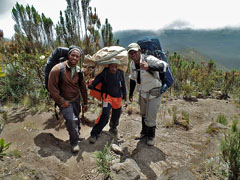 Ahi, Anton and Penda on the trail. |
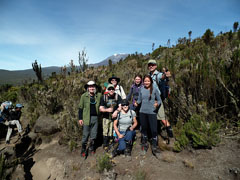 Our first sight of Kili while on the hike. |
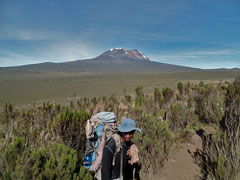 Kilimanjaro and Adam. |
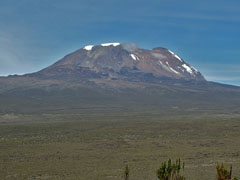 Kilimanjaro. |
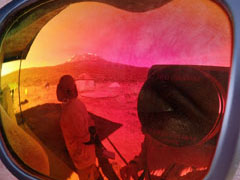 Penda & Kili in Todd's glasses. |
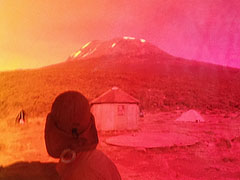 Close up of Kili & Penda. |
|
Shira
I was in a picture perfect spot. It was great to see the
camp with the mountain looming in the distance. I got a great
picture of the mountain (and the back of Penda's head!) reflecting off
of Todd's shiny sunglasses. I thought it turned out kind of cool
(see above). The other thing I noticed here is that there must be
a hundred long-drop outhouses strewn about. I walked around some
and got a shot of Kili and the long-drops which I found kind of humorous. Although it was pleasantly warm when we arrived at camp, when the sun set it got cold fast. We are now at 11,500 feet and one would think that would be expected. But, I did some research on the weather and a site I visited often kept telling me that the highs and lows were virtually identical every day. Well, that was rubbish and I still don't understand what the issue was here. It got cold every night but it was usually quite pleasant every day. Given that we are only 3° south of the equator, the days are remarkably uniform in length - 12 hours of day and 12 hours of night. Sunrise is at 6:30 a.m. and sunset is at 6:30 p.m. every day. This night we started dinner late and it was dark while we were eating. The one quibble I had during this trip, and I put it down on my evaluation, was the insufficient lighting in the dining tent for late dinners. I took to using my headlamp for dinner, but I think a string of LEDs stretched across the top, ala the new Big Agnes mtnGLO tents, would suffice. Still, dinner was great. We always started with soup and we were all big fans of that each day. This night we had lasagna, which may have been the best meal of the whole trip. I could have stood to have it a couple more times over the nine days we had. From now on, when we return to our tents at night we will be carrying with us a liter bottle filled with boiling hot water. Tucked into the sleeping bag it helps keep things warm all night, and is easy to drink in the morning versus the ice cold stuff that was sitting around in our tent all night. I jumped into my liner and sleeping bag and pulled my space blanket bivy over me to warm up. It took about 20 minutes. Then I was able to get some things done in the tent, including the first and only time I wrote in my journal. The next morning I noticed that even though I just had my space blanket loosely over my sleeping bag it was doing far too good a job of trapping the moisture underneath it and making my sleeping bag wet. OK, that idea didn't work out and I didn't use it again for the rest of the trip. |
|
Day 3 - Tuesday, July 14, Shira
I
Camp to Shira II
Camp Although I felt well the day before, I don't think I got good sleep the last night and was getting more sickly this day, with a developing fever. My throat seemed better but I found myself going hoarse and wasn't able to do much talking. We are up at our usual time. I am fascinated by the local ravens. They are very large, have huge beaks and a very distinctive white patch on the back of their necks. We see them at all the camps and even at the summit on day seven. The hiking is fine, but I get tired quickly and whenever we get a chance to stop I am on the ground and trying to close my eyes. I just want to take a nap, but we must continue on. The hiking is pretty easy as we transition to the moorlands, where mostly the plants are smaller with one exception - the giant Senecio plants. They grow up and the old leaves die while new ones grow up above them. Some of these plants were seven or eight feet tall. Now, they do remind me a bit of our yucca, but the Senecio are not sharp and spiny. Today we were hiking across the Shira Plateau. Kilimanjaro is actually made up of three volcanoes - Shira, Kibo and Mawenzi. When we see pictures of Kilimanjaro, we are actually looking at the Kibo crater. Shira has worn down into this high plateau and Mawenzi, to the east, is a jagged peak that tops out at about 2500 feet lower than Kibo. Thankfully, today is a short day. It only takes us about four and a half hours to reach the Shira II camp. There is an emergency road that comes up to this camp, so those that need evacuation from this side of the mountain need only to get here before being able to quickly descend the rest of the way to Arusha. |
|
|
||
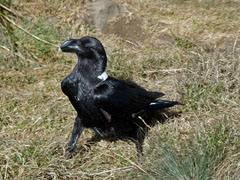 Tanzanian raven - camp follower. |
 Day 3 - hiking the moorland. |
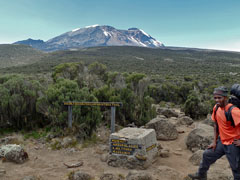 Ahi at trail junction. |
 Foster of Kilimanjaro. |
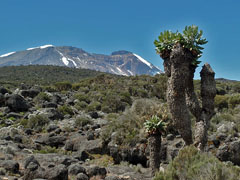 Kilimanjaro flanked by giant Senecio. |
 Shira II camp (12,800 ft.). |
| While we arrived at Shira II quickly, and actually ate our lunch here, our day wasn't done. In the afternoon we take an "acclimatization" hike up to about 14,000 feet, which is about 1200 feet above our camp. We just needed to bring water and our "po-le, po-le" attitude. That went pretty well, although I was still quite tired. Adam pointed out a Lobelia plant that produces small blue blossoms just before it dies off. Cool looking plant. |
|
|
||
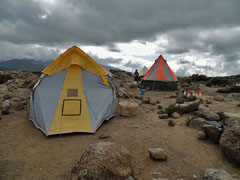 Dining & kitchen tents. |
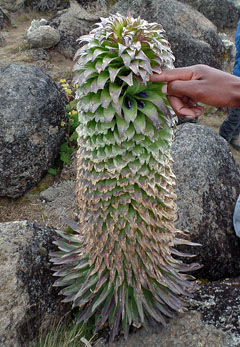 While on our acclimatization hike Adam pointed out this Lobelia plant and its blue blossoms. |
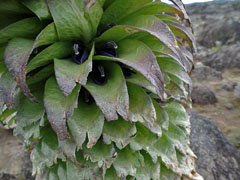 Blue blossoms. |
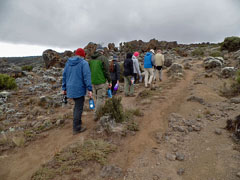 Acclimatization hike to 14,000 ft. |
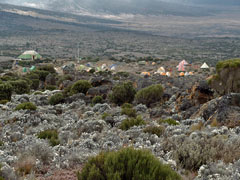 Coming back to Shira II camp. |
|
| Once again I had an awful night and got very little sleep. I know that I was somewhat out of it early on as I was speaking gibberish to myself. That was the fever talking. I was hoping that this would be the end of it, but no such luck. I think by now I was taking the Benadryl that Dewey had given me, but that was it in terms of trying to deal with this. Once again my appetite sank and I was barely able to eat about half of what everyone else was eating. |
|
|
|
Best of the rest - Other photos
from this part of the trip by the other members of the group. |
|
|
| From Mark |
|
|
||
|
|
Go on to
Kilimanjaro - Part III page |
|